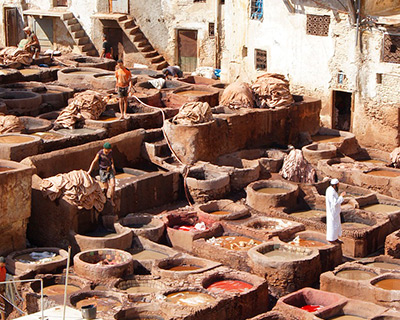INVEST/2023/173
Title: Previously unknown microbes able to adapt to hexavalent chromium contamination
Research group: Microbial Single-Cell Genomics
The tanning industry faces significant environmental problems due to the use of chemicals that generate wastewater contaminated with heavy metals, sulfides and toxic substances. These effluents, which often exceed permitted limits, threaten ecosystems by contaminating groundwater, rivers and agricultural soils, affecting the food chain and human health. To mitigate pollution, advanced water treatment technologies and environmentally friendly chemical alternatives are required, but this poses challenges, especially in low-income countries. The presence of hexavalent chromium (Cr6+), known to be carcinogenic, is a prominent concern, as it is formed during the tanning process and persists in effluents despite treatment efforts.
One of the possibilities for reducing Cr6+ in the environment surrounding tanneries is bioremediation by bacteria. A variety of bacterial strains belonging to dozens of culturable genera have been discovered with the ability to reduce Cr6+. However, these extreme ecosystems contain a large number of bacteria that cannot be isolated in the laboratory. Recent advances in sequencing technologies, such as metagenomics and single cell genomics, have enabled the discovery of new bacterial species and their metabolic potential without the need for culture. However, the extreme ecosystems created by industrial activities are not widely studied, perhaps due to the complexity of the bioinformatics problem that requires highly trained bioinformaticians in the research team. There are only a few assembled genomes of tannery effluent metagenomes published to date.
This project proposal is inspired by samples from a Tunisian tannery, which were brought to our laboratory by a visiting PhD student from the University of Gafsa, Tunisia. The student isolated 9 strains from this tannery and tested their ability to reduce chromium. In our laboratory we sequenced these strains and revealed that they represent 7 new Enterococcus strains and 2 new Bacillus strains. However, these cultured microbes form only a miniscule portion of the entire microbial community in the effluent from this tannery.
Our main objective is to see which metabolic pathways are activated in these non-culturable microbes at high concentrations of heavy metals and then design new bioremediation strategies. Another objective is to study interactions between microbes in this unique ecosystem through single cell genomics, which may serve to increase bio-remediation capacity.
systems biology, MAGs, single cell genomics, metagenomics, tannery effluent, wastewater microbiom
- Dzunkova, Maria
- PI-Invest Disting Exper.Internacional
Generalitat Valenciana
Universitat de València















